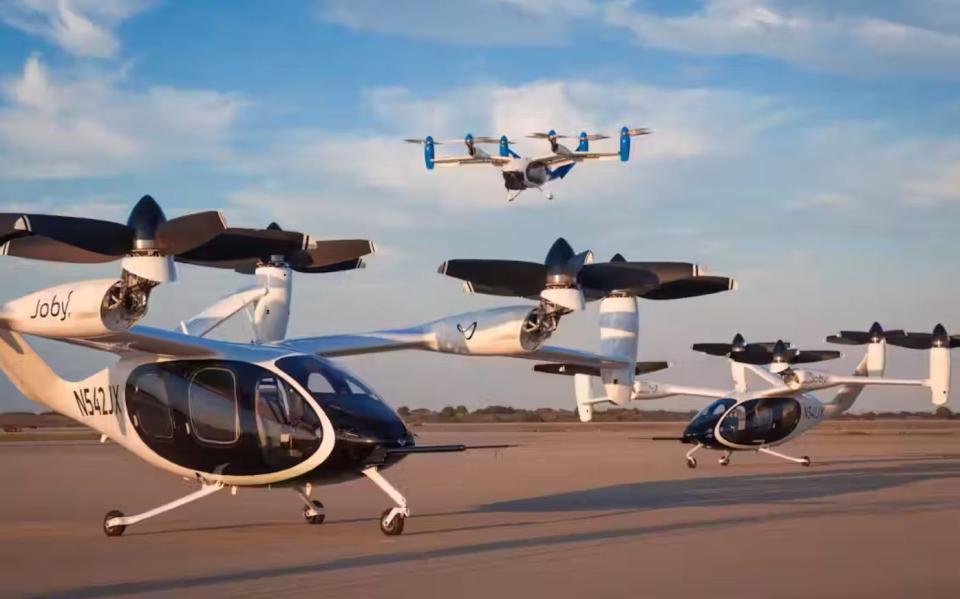Toyota Is Betting—Again—on This Air Taxi Startup

Toyota reveals it will invest an additional $500 million in Joby Aviation, which is developing an electric air taxi for urban flight routes.
The startup has recently completed its third production aircraft, which features an all-electric range of about 100 miles.
The air taxi industry is expected by some industry analysts to surge in popularity by the end of the decade, but significant regulatory and pricing barriers remain.
The gleaming future in which we all zoom around in electric air taxis may not quite be here—instead it's just Zoom calls—but this isn't stopping automakers from supporting air taxi startups in a major way.
Toyota is one such backer of an electric vertical take-off and landing (eVTOL) startup, Joby Aviation, and it has just revealed a planned $500 million investment aimed at developing electric air taxis to be used as part of commercial passenger service.
This financial commitment will bring Toyota's total investment in Joby to $894 million, and it's aimed at the certification and commercial production of the startup's planned air taxi. In fact, the two companies have been working together for quite some time.
"Today's investment builds on nearly seven years of collaboration between our companies," said JoeBen Bevirt, founder and CEO of Joby Aviation.
Joby has recently completed its third eVTOL craft at its pilot production line in California and is gearing up to begin building yet another assembly facility. The startup is also making progress on aircraft type certification, having reached the fourth of five certification stages.
But another hinted longer-term goal of this partnership is to create a manufacturing alliance for the commercialization of Joby's air taxis.
Toyota engineers have already been working alongside Joby employees on tooling and manufacturing design, as the company has approached the pilot production phase of the process, with the automaker also scheduled to provide powertrain components for the craft.
Last November Joby's eVTOL craft saw its first flight in an urban area, with the startup bringing the six-rotor craft to New York City, one of the metro areas long hoped to benefit from such aircraft.
Joby's debut four-passenger model promises a range of 100 miles, revealing plans to partner with Delta Airlines in the NYC area to effectively take over some routes currently served by noisy and expensive helicopters.
We are now a few years out from that impossibly slick UberAIR video, which painted a picture of seamless travel from small airports positioned on skyscraper rooftops, presumably without TSA lines, satellite parking lots located a zip code away, or requirements to arrive half an hour before departure.
That orange-tinged future has remained firmly in the subfolders of CGI rendering software, even though quite a few prototypes have since taken to the skies, with larger business model concerns proving to be a bigger hurdle than the tech alone.
Still, eVTOL craft are expected to achieve some measure of use in the coming years, with a recent study by Juniper Research proposing that the Advanced Air Mobility (AAM) revenues will reach $6 billion by 2030, representing a major hike from a predicted $31 million in 2025.
Of course, just about everything would have to unfold in a manner favorable to eVTOL craft, and we are once again reminded that we were told 10 years ago that this gleaming eVTOL future would get here by the mid-2020s. Glancing at our watch, that's practically right now.
The main competitor facing eVTOL craft is perhaps an unexpected one, and it's not older, noisier helicopters.
Rather, it is slower robotaxis that can actually pick up passengers curbside when summoned via an app, and at the moment they seem to have a distinct advantage in transparent number and price per trip, even if they (usually) do not go airborne.
Will eVTOL craft become a major industry by decade's end, edging out helicopters to some degree, or is this view too optimistic? Let us know what you think in the comments below.

 Yahoo Autos
Yahoo Autos 